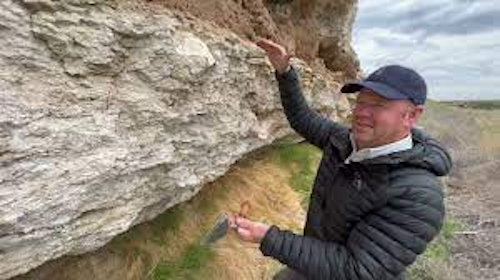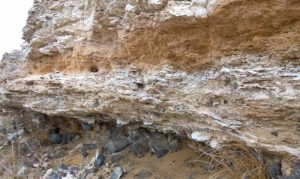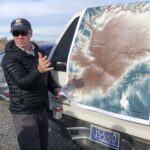
The Lecture: Soil-climate evidence for timing of the Cascade uplift and creation of its rain shadow
 Calcrete is a CaCO3-rich hardpan paleosol that forms in dry, stable landscapes of the world. Calcrete in eastern Washington cements a 20-m-thick interval across three geomorphic domains: Palouse Hills, Channeled Scablands, and Yakima Fold Belt. The sheet-like calcrete deposit encloses ancient Scabland flood gravels and defines a regional paleosurface that has been bent and broken by Quaternary faults. Calcrete overprints primarily lowland alluvial deposits (ancestral Columbia-Snake River floodplain) and basaltic alluvial fan gravels shed from fault-bounded ridges. Thick layers of pedogenic carbonate accumulated during the Pleistocene, between about 1.8 million years ago to about 40 thousand years ago, but older cements at somewhat deeper levels date back to ~7 million years (late Miocene). The appearance of arid-land calcrete in eastern Washington coincides with the topographic rise of the Cascade Range and establishment of a strong rain shadow east of the divide. This lecture shed new light on this lesser-known part of eastern Washington’s stratigraphy.
Calcrete is a CaCO3-rich hardpan paleosol that forms in dry, stable landscapes of the world. Calcrete in eastern Washington cements a 20-m-thick interval across three geomorphic domains: Palouse Hills, Channeled Scablands, and Yakima Fold Belt. The sheet-like calcrete deposit encloses ancient Scabland flood gravels and defines a regional paleosurface that has been bent and broken by Quaternary faults. Calcrete overprints primarily lowland alluvial deposits (ancestral Columbia-Snake River floodplain) and basaltic alluvial fan gravels shed from fault-bounded ridges. Thick layers of pedogenic carbonate accumulated during the Pleistocene, between about 1.8 million years ago to about 40 thousand years ago, but older cements at somewhat deeper levels date back to ~7 million years (late Miocene). The appearance of arid-land calcrete in eastern Washington coincides with the topographic rise of the Cascade Range and establishment of a strong rain shadow east of the divide. This lecture shed new light on this lesser-known part of eastern Washington’s stratigraphy.
 The Speaker
The Speaker
Skye is a field geologist who specializes in mapping, paleosols, and geomorphology. His work focuses on the interplay between tectonics, topography, and climate. Skye received his BSc. in Geology from Whitman College and his MSc. from the University of Wyoming. He has been a Soil Scientist for the Colville Confederated Tribes and taught Geosciences at Boise State University.
Currently, Skye is mapping the surficial geology of the Mission Valley in northwest Montana and sorting out the geomorphic history of calcretes in Eastern Washington. Skye’s hobbies include woodworking, nordic skiing, and motor-cycles. Skye is married to Hilary, manager of the Grizzly Bear Program for the U.S. Fish and Wildlife Service. They live with their hound dog, Lucy, in northwest Montana.
